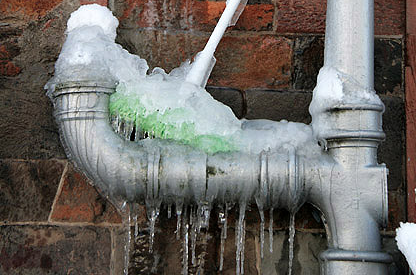How to Safeguard Plumbing System from Cold Weather: Essential Advice
How to Safeguard Plumbing System from Cold Weather: Essential Advice
Blog Article
We've noticed the article about 6 Ways to Prevent Frozen Pipes listed below on the web and accepted it made sense to talk about it with you here.

Winter can ruin your pipes, especially by freezing pipelines. Right here's exactly how to prevent it from taking place and what to do if it does.
Introduction
As temperatures drop, the risk of icy pipes increases, possibly bring about pricey fixings and water damage. Comprehending exactly how to prevent icy pipelines is important for property owners in chilly climates.
Understanding Icy Pipelines
What causes pipes to ice up?
Pipes ice up when subjected to temperature levels listed below 32 ° F (0 ° C) for prolonged periods. As water inside the pipelines freezes, it broadens, putting pressure on the pipeline wall surfaces and possibly triggering them to rupture.
Threats and damages
Icy pipelines can result in water supply disturbances, home damages, and expensive repairs. Ruptured pipelines can flood homes and create extensive architectural damage.
Signs of Frozen Pipes
Recognizing frozen pipes early can prevent them from rupturing.
Just how to recognize frozen pipes
Look for lowered water circulation from faucets, unusual smells or noises from pipelines, and visible frost on revealed pipelines.
Prevention Tips
Shielding susceptible pipes
Wrap pipes in insulation sleeves or make use of warmth tape to protect them from freezing temperatures. Focus on pipelines in unheated or exterior locations of the home.
Home heating strategies
Maintain interior spaces properly heated up, particularly locations with plumbing. Open cabinet doors to enable cozy air to circulate around pipes under sinks.
Safeguarding Exterior Pipes
Yard hoses and outdoor taps
Separate and drain pipes garden pipes prior to winter season. Install frost-proof faucets or cover outdoor faucets with shielded caps.
What to Do If Your Pipes Freeze
Immediate actions to take
If you suspect icy pipes, keep taps available to soothe pressure as the ice melts. Use a hairdryer or towels soaked in hot water to thaw pipelines gradually.
Long-Term Solutions
Architectural adjustments
Consider rerouting pipelines far from outside wall surfaces or unheated locations. Include additional insulation to attics, cellars, and crawl spaces.
Updating insulation
Invest in high-grade insulation for pipes, attic rooms, and walls. Proper insulation aids maintain regular temperatures and decreases the threat of icy pipes.
Final thought
Preventing frozen pipes requires proactive procedures and fast feedbacks. By recognizing the reasons, indicators, and safety nets, homeowners can protect their plumbing during cold weather.
5 Ways to Prevent Frozen Pipes
Drain Outdoor Faucets and Disconnect Hoses
First, close the shut-off valve that controls the flow of water in the pipe to your outdoor faucet. Then, head outside to disconnect and drain your hose and open the outdoor faucet to allow the water to completely drain out of the line. Turn off the faucet when done. Finally, head back to the shut-off valve and drain the remaining water inside the pipe into a bucket or container. Additionally, if you have a home irrigation system, you should consider hiring an expert to clear the system of water each year.
Insulate Pipes
One of the best and most cost-effective methods for preventing frozen water pipes is to wrap your pipes with insulation. This is especially important for areas in your home that aren’t exposed to heat, such as an attic. We suggest using foam sleeves, which can typically be found at your local hardware store.
Keep Heat Running at 65
Your pipes are located inside your walls, and the temperature there is much colder than the rest of the house. To prevent your pipes from freezing, The Insurance Information Institute suggests that you keep your home heated to at least 65 degrees, even when traveling. You may want to invest in smart devices that can keep an eye on the temperature in your home while you’re away.
Leave Water Dripping
Moving water — even a small trickle — can prevent ice from forming inside your pipes. When freezing temps are imminent, start a drip of water from all faucets that serve exposed pipes. Leaving a few faucets running will also help relieve pressure inside the pipes and help prevent a rupture if the water inside freezes.
Open Cupboard Doors
Warm your kitchen and bathroom pipes by opening cupboards and vanities. You should also leave your interior doors ajar to help warm air circulate evenly throughout your home.

We were shown that article about Preventing and dealing with frozen pipes through a pal on another website. Sharing is nice. You won't know, you may very well be doing someone a favor. Thanks for taking the time to read it.
Click Here Report this page